

Vol. 39 (Number 44) Year 2018. Page 25
Tamires Andrade da SILVA 1; Giselle Alves da PAIXÃO 2; Julio Henrique Rodrigues GOMES 3; Tamares Andrade da SILVA 4; Isabelle de Argolo MELO 5; Luciano Aparecido Meireles GRILLO 6; Camila Braga DORNELAS 7
Received: 11/05/2018 • Approved: 05/06/2018
3. Results---
ABSTRACT: The low interest of the pharmaceutical industry for research related to neglected diseases, the knowledge produced does not revert to therapeutic advances, reflecting extremely limited chemotherapies. In this context, the nanotechnology can be useful, since the use of nanoparticles as nanostructured carriers can increase several of the original properties of a drug, as well as to overcome limitations presented by it. This technological prospect deals with the current status of nanotechnology focused on the treatment of neglected diseases. |
RESUMEN: Devido ao baixo interesse da indústria farmacêutica para pesquisas relacionadas às doenças negligenciadas, o conhecimento produzido não se reverte em avanços terapêuticos, refletindo quimioterapias extremamente limitadas. É neste contexto que a nanotecnologia pode ser útil, visto que a utilização de nanopartículas como carreadores nanoestruturados, pode incrementar diversas das propriedades originais de um fármaco, bem como contornar limitações apresentadas pelo mesmo. Esta prospecção tecnológica lida com o status atual da nanotecnologia voltada para o tratamento de doenças negligenciadas. |
The World Health Organization (WHO) and Doctors Withou Borders (MSF) classified diseases in three types: global, neglected and extremely neglected (Chung et al., 2008). Visceral leishmaniasis and Chagas disease are examples of extremely neglected diseases, which occur almost exclusively in poor countries, that is, they affect people who barely have access to basic necessities for survival and, for this reason, are unable to attract the interest of the industry pharmaceutical. Thus, treatment options become limited and government efforts to fight these types of diseases are insufficient (Chung et al., 2008; DNDi, 2013).
In this context, nanotechnology has been one of the resources used in relation to neglected diseases, so that it has two approaches regarding the treatment of these infections. First, it is the design of delivery systems for conventional drugs using nanocarriers, which is increasingly receiving the attention of several researchers because of the improved pharmacokinetic properties that can be achieved through these therapies (Akbari et al., 2017).
Thus, these systems result in a greater potentiation of the action with reduction of the toxic effects, implying in the metabolism of the drug, including absorption, distribution and excretion (Vyas e Gupta, 2006). Furthermore, this effect of delivery of the target to the specific site increases bioavailability and provides protection, thus favoring a longer time of permanence of the drug in organs such as liver, kidneys and spleen, prolonging the time between administrations (Gershkovic et al., 2009).
The second approach is related to the nanometer scale of these systems. As an example, macrophages phagocyte the nanoparticles as foreign bodies causing the specific delivery to leishmania within the target macrophages of the disease (Muller et al., 2001; Menezes et al., 2014; Kumara et al., 2014). These nanoparticles are also used in the diagnosis of these infectious diseases, because they have large surface areas, special chemical, physical and mechanical properties (Qasim et al., 2014). Thus, new drug delivery systems and new treatment regimens are being designed and applied. Table 1 summarizes the main alternatives investigated so far for the treatment of leishmaniasis.
Amphotericin B is the only example of a nanotechnology drug that is already used in the treatment of leishmaniasis, liposomal amphotericin B (AmBisome®, Gilead Sciences, Inc, Foster City, EUA) (Chávez-Fumagalli et al., 2015).
Table 1
Relationship of studies using leishmanicide drugs in nanocarriers
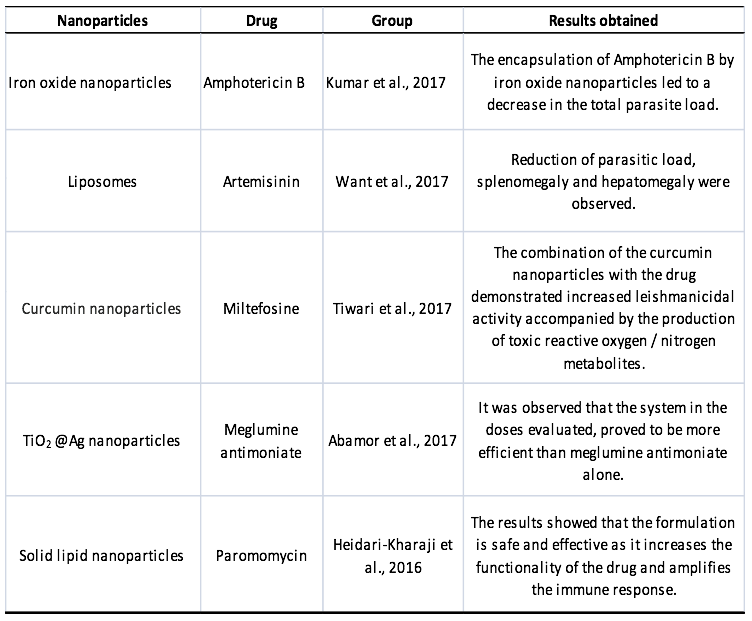
Source: Author’s own (2018)
Thus, this work proposed the investigation of the quantity of articles and patent deposits in Brazil and in the world, resulting from the association of several neglected diseases with nanotechnology, through the use of nanoparticles, thus presenting an overview of the current state of scientific development and technological.
The survey was conducted on the patent data source deposited in the World Intellectual Property Organization (WIPO), Patent Lens (LENS), European Patent Office (EPO), United States Patent and Trademark Office (USPTO), and the database of the National Institute of Industrial Property (INPI) in Brazil. Scientific review consisted of analyzing the bases of SCIENCE DIRECT, PUBMED, SCIELO, WEB OF SCIENCE e SCOPUS.
The prospective study was conducted in April 2018 and comprised all the available years in the databases, selecting the option of the keywords contained in the “title” and/or “abstract”. The keywords surveyed included neglected diseases, a) Chagas disease, b) Schistosomiasis, c) Leishmaniasis, d) Malaria, e) Leprosy, f) Tuberculosis, g) Toxoplasmosis, h) Dengue, i) Filariasis and j) Onchocerciasis. Then, the terms “Neglected diseases” and “Nanoparticles”, finally, the latter associated with diseases through the Boolean operator “AND”.
First, in figure 1 is presented the sum of the number of articles found in the databases according to the diseases investigated. The tuberculosis led the ranking (297,997), this is justified by the fact that its infection is considered devastating and the eradication unattainable, being the third cause of death among women worldwide (Wang et al., 2013; Choudhary and Devi, 2015).
Figure 1
Distribution of each neglected disease according to the
databases searched. Source: Author's own (2018)
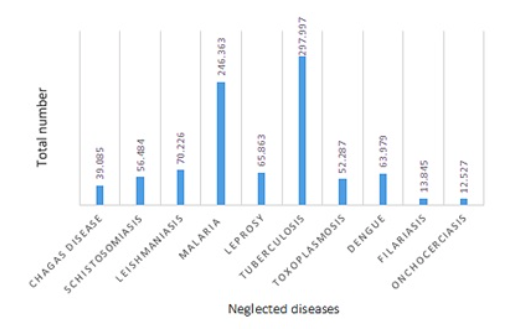
Malaria, leishmaniasis and leprosy also present expressive numbers, with 246,363, 70,226 and 65,863 articles respectively.
Next, the number of articles published per database was evaluated according to the terms used below (Table 2). Many documents were found involving the searched terms in isolation, with 20,747 papers being found for the term “Neglected diseases” and 828,531 for “Nanoparticles”.
Table 2
Results of the search for scientific articles in the databases Science direct, Pub Med, Scielo, Web of Science and Scopus
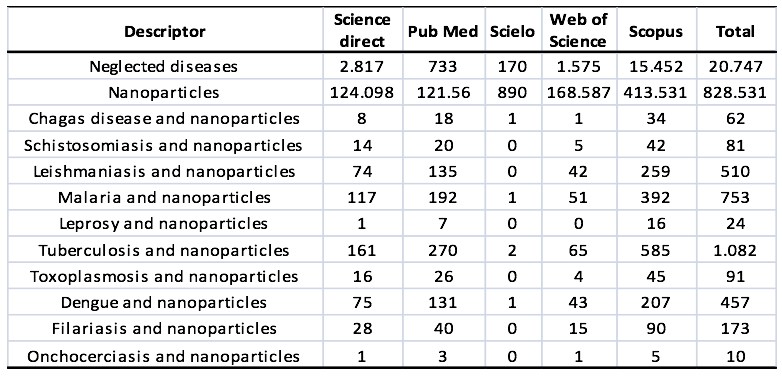
Source: Author's own
The descriptor with the highest number of articles was "Tuberculosis and nanoparticles” (1,082), in this way the research was conducted in order to better explore the information related to the evolution of these articles per year and distribution by country.
The number of articles published per year is represented in figure 2, in the years 2000 to the present moment of the study, 1,049 articles were found. A recent review indicates that the main nanoparticles investigated are the liposomes, polymer nanoparticles, dendrimers and solid lipid nanoparticles (Choudhary and Devi, 2015).
The year that most the publications occurred was that of 2017 (186), affirmed that nanotechnologies offer great potential to treat and eradicate these diseases. Until the first half of 2018 there are already 68 articles, and this number tends to increase.
Figure 2
Number of articles per year in all bases investigated. Source: Author's own (2018)
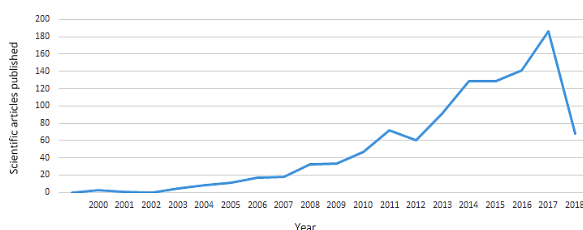
In figure 3 is presented the five countries that most published. India leads with 179 articles, followed by the USA (117) and China (60). Epidemiological data indicate that only India and China account for 26% and 12% of total cases (OMS, 2013). Moreover, between 2012-2013, out of 9 million Tuberculosis cases, it’s estimated that 2,3 million have occurred in India (OMS, 2014). It is believed that because they are high prevalence countries, research stimuli should be larger, justifying the number of publications for these two countries.
Figure 3
Distribution of countries. Source: Author's own (2018)
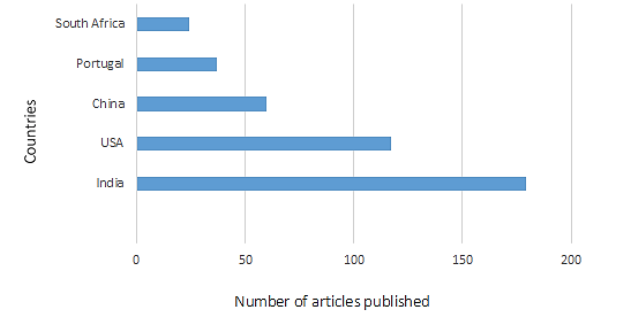
Continuing, the analysis was followed by search of deposited patents related to the chosen keywords (Table 3).
When the term "Neglected diseases" was used, it was observed that the number of patent applications filed is very low (103), reflecting the lack of interest of the pharmaceutical market in relation to these diseases in view of the affected target public. However, many documents were found involving the term "nanoparticles", WIPO (45,761), LENS (82,141), EPO (10,000), USPTO (6,022), and INPI (6), with a total of 143,930 patents.
When analyzing the various diseases associated with the term "Nanoparticles", it is possible to observe that for Chagas disease, schistosoma, leprosy, toxoplasmosis, onchocerciasis there are no patents deposited. Leishmaniasis, malaria, tuberculosis, dengue and filariasis presented 7, 31, 89, 39, 1 respectively, and are still considered very low numbers, considering the severity of these diseases, such as leishmaniasis, with about 350 million people in and approximately 12 million cases of infection worldwide (Akhoundi et al., 2016).
Table 3
Number of patent deposits in the databases WIPO1, LENS2, EPO3, USPTO4 and INPI5
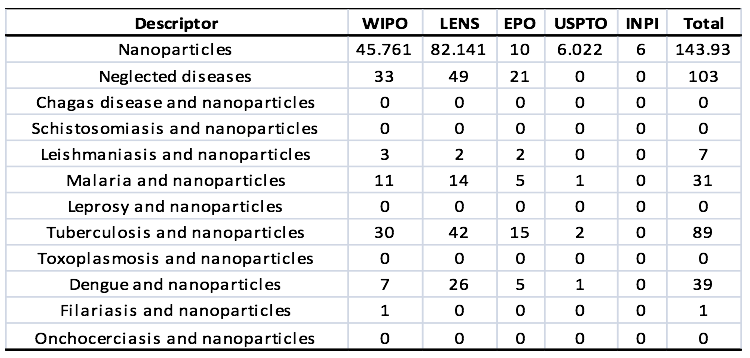
Legend: ¹World Intellectual Property Organization, 2 Patent Lens, 3 European
Patent Office, 4 United States Patent and Trademark Office, and
5 National Institute of Industrial Property. Source: Author's own (2018)
Tuberculosis, as was expected, given the fact that it presented the largest number of articles, also led in relation to patents (89). The database with the highest number of patents was LENS (42) as shown in figure 4.
Figure 4
Distribution of patents by databases. Source: Author's own (2018)
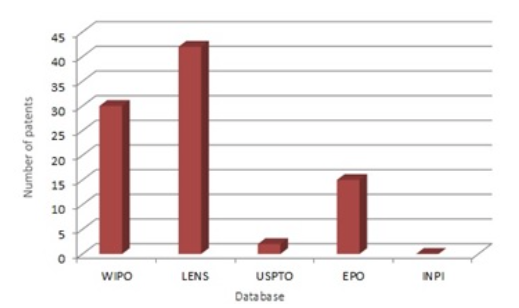
Regarding the number of deposits per year, the first patent was deposited in 2004, and since then its growth is evident, with a peak in 2009, with 13 patent deposits, and a slight decrease until 2012, according to Figure 5.
Figure 5
Number of patents per year of deposit. Source: Author's own (2018)
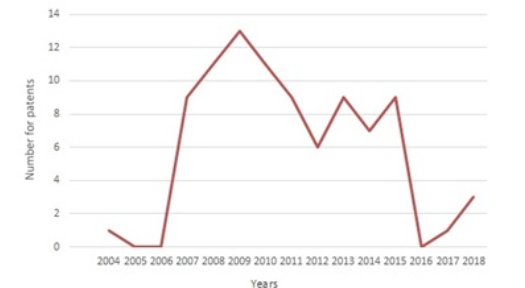
On patents studied in all databases, figure 6 shows that Russia leads the ranking, followed by the USA, India, China and Canada. These countries hold 19 out of 55, or about 34.5% of the world sum. According to the International Patent Classification (IPC) observed in LENS, the highest number of records was classified as A61P31 / 06 (17), related to "anti-infectives, that is antibiotics, antiseptics and chemotherapeutics", specifically for tuberculosis.
Figure 6
Number of patents filed by country. Source: Author's own (2018)
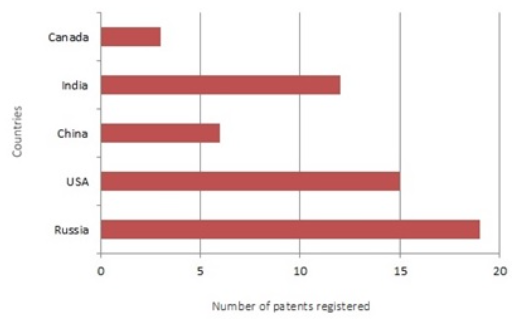
This technological prospecting article presents concise but detailed information regarding the latest advances in neglected diseases associated with nanotechnology, focusing on the use of nanoparticles. Based on the results obtained it was possible to survey 942,733 and 203,531 articles and patents, respectively, and the database that registered the most was SCOPUS and LENS. The mapping of articles and patents with diseases associated with the term "Nanoparticles" revealed that there is a strong interest in the use of nanotechnology for the treatment of tuberculosis and a low interest in diseases such as oncorcercosis and filariosis. Although the overall still demonstrate little investment in research, justified by the low potential for profitable returns to the pharmaceutical industry.
Abamor, E. S., Allahverdiyev, A. M., Bagirova, M., & Rafailovich, M. (2017). Meglumine antımoniate-TiO2@Ag nanoparticle combinations reduce toxicity of the drug while enhancing its antileishmanial effect. Acta Tropica, 169, 30-42.
Akbari, M.; Oryan, A.; & Hatam, G. (2017). Application of nanotechnology in treatment of leishmaniasis: A Review. Acta Tropica, 172, 86-90.
Akhoundi, M., Kuhls, K., Cannet, A. Votýpka, J., Marty, P., Delaunay, P., & Sereno, D. (2016). A Historical Overview of the Classification, Evolution, and Dispersion of Leishmania Parasites and Sandflies. PLOS Neglected Tropical Diseases, 10, 6.
Brajendra, T., Richa, P., Pradeep, K., Srikanta, K. R., Kailash, C. G., & Neena, Gl. (2017). Nanotized Curcumin and Miltefosine, a Potential Combination for Treatment of Experimental Visceral Leishmaniasis. Antimicrobial Agents Chemotherapy, 61, 3.
Chávez-Fumagalli, M. A., Ribeiro, T. G., Castilho, R. O., Fernandes, S. O. A., Cardoso, V. N., Coelho, C. S. P.,... Coelho, E. A. F. (2015). New delivery systems for amphotericin B applied to the improvement of leishmaniasis treatment. Revista da Sociedade Brasileira de Medicina Tropical, 48, 3, 235-242.
Choudhary, S., & Kusum, D. V. (2015). Potential of nanotechnology as a delivery platform against tuberculosis: Current research review. Journal of Controlled Release, 202, 65-75.
Chung, M. C., Ferreira, E. I., Santos, J. L., Giarolla, J., Rando, D. G., Almeida, A. E.,… Blau, L. (2008). Prodrugs for the treatment of neglected deseases. Molecules, 13, 616-677.
Drugs for Neglected Diseases initiative (DNDi). Doenças Negligenciadas. (2013). Recovered from: < http://www.dndi.org.br/pt/doencas-negligenciadas.html>
German, A. I., Durán, M., Cacicedo, M. L., Nakazato, G., Kobayashi, R. K. T., Martinez, D. S. T.,... Durán, N. (2017). Nanopharmaceuticals as a solution to neglected diseases: Is it possible? Acta Tropica, 170, 16-42.
Gershkovich, P., Wasan, E. K., Lin, M., Sivak, O., Leon, C. G., Clement, J. G., & Wasan, K. M. (2009). Pharmacokinetics and biodistribution of amphotericin B in rats following oral administration in a novel lipid-based formulation. Journal of Antimicrobial Chemotherapy, 64, 101-108.
Heidari-Kharaji, M., Taheri, T., Doroud, D., Habibzadeh, S., Badirzadeh, A., & Rafati, S. (2016). Enhanced paromomycin efficacy by solid lipid nanoparticle formulation against Leishmania in mice model. Parasite Immunology, 38, n. 10, 599-608.
Kumar, R., Pandey, K., Sahoo, G. C., Das, S., Das, V., Topno, R. K., & Das, P. (2017). Development of high efficacy peptide coated iron oxide nanoparticles encapsulated amphotericin B drug delivery system against visceral leishmaniasis. Materials Science and Engineering C, 75, 1465-1471.
Kumar, R., Sahoo, G. C., Pandey, K., Das, V., & Das, P. (2014). PLGA-PEG Encapsulated sitamaquine nanoparticles drug delivery system against Leishmania donovani. Journal of Scientific and Industrial Research, 3, 85-90.
Menezes, J., Silva, T., Santos, J., Catari, E., Meneghetti, M., Matta, C.,… Dornelas, C. (2014). Layered Double Hydroxides (LDHs) as carrier of antimony aimed for improving leishmaniasis chemotherapy. Applied Clay Science, 127, 91–92.
Müller, R. H., Jacobs, C., & Kayser, O. (2001). Nano suspensions asparticulate drug formulations in therapy: rationale for development and what we can expect for the future. Advanced Drug Delivery Reviews, 47, 3-19.
OMS. Organização Mundial da Saúde. Global tuberculosis report 2014. (2014). Recovered from: <http://apps.who.int/iris/handle/10665/137094>.
OMS. Organização Mundial de Saúde Leishmaniasis. (2013). Recovered from: <http://gamapserver.who.int/mapLibrary/app/searchResults.aspx>.
Qasim, M., Lim, D. J., Park, H., & Na, D. (2014). Nanotechnology for diagnosis and treatment of infectious diseases for diagnosis and treatment of infectious diseases. Journal of Nanoscience and Nanotechnology, 14, 7374-7387.
Vyas, S. P., & Gupta, S. (2006). Optimizing efficacy of amphotericin B through nanomodification. International Journal of Nanomedicine, 1, 417-432.
Wang, Y., Zhang, D., Bao, Q., Wu, J., & Wan, Y. (2012). Controlled drug release characteristics and enhanced antibacterial effect of graphene oxide-drug intercalated layered double hydroxide hybrid films. Journal of Materials Chemistry, 22, 23106-23113.
Want, M. Y., Islammudin, M., Chouhan, G., Ozbak, H. A., Hemeg, H. A., Chattopadhyay, A. P. & Afrin, F. (2017). Nanoliposomal artemisinin for the treatment of murine visceral leishmaniasis. International Journal of Nanomedicine, 12, 2189-2204.
1. Doctoral student in the Post-Graduate Program in Health Sciences, Federal University of Alagoas - UFAL. Email: tamires_a@hotmail.com
2. Graduate of the Pharmacy Program at the Federal University of Alagoas. Email: giselle.alves16@gmail.com
3. Graduate of the Pharmacy Program at the Federal University of Alagoas. Email: juliohgomess@gmail.com
4. Graduate of the Dentistry Program at the Federal University of Alagoas. Email: tam_andrade@hotmail.com
5. Graduate of the Dentistry Program at the Federal University of Alagoas. Email: argoloisabelle@gmail.com
6. Professor, Federal University of Alagoas - UFAL. Email: lucianomeirelesgrillo@gmail.com
7. Professor, Federal University of Alagoas - UFAL. Email: dornelascb@yahoo.com.br